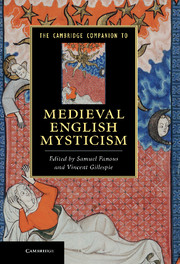Book contents
- Frontmatter
- Contents
- List of contributors
- Preface
- Chronology
- List of abbreviations
- 1 Introduction
- 2 c. 1080–1215: culture and history
- 3 c. 1080–1215: texts
- 4 1215–1349: culture and history
- 5 1215–1349: texts
- 6 1349–1412: culture and history
- 7 1349–1412: texts
- 8 1412–1534: culture and history
- 9 1412–1534: texts
- 10 1534–1550s: culture and history
- 11 1534–1550s: texts
- Guide to further reading
- Glossary of theological terms
- Index
- References
7 - 1349–1412: texts
Published online by Cambridge University Press: 28 July 2011
- Frontmatter
- Contents
- List of contributors
- Preface
- Chronology
- List of abbreviations
- 1 Introduction
- 2 c. 1080–1215: culture and history
- 3 c. 1080–1215: texts
- 4 1215–1349: culture and history
- 5 1215–1349: texts
- 6 1349–1412: culture and history
- 7 1349–1412: texts
- 8 1412–1534: culture and history
- 9 1412–1534: texts
- 10 1534–1550s: culture and history
- 11 1534–1550s: texts
- Guide to further reading
- Glossary of theological terms
- Index
- References
Summary
This chapter opens with the death of Richard Rolle, who perished in the Black Death (1348–9), which decimated the population of the British Isles. It coincides with what was to become known as the Hundred Years' War with France, and ends in 1413 with the death of Henry IV. In 1399 Henry had deposed his cousin Richard II, who had become king as a 10-year-old boy in 1377, when his grandfather, Edward III, died. The reigns of the two grandsons witnessed periods of enormous social, political, and religious turmoil. Paradoxically, Richard's reign coincided with a brilliant flowering of secular vernacular literature, for which John Burrow first coined the term ‘Ricardian’, and whose major figures include Chaucer, Gower, Langland, and the so-called Gawain-poet. No less prestigious are developments, both original and translated, in religious vernacular writing, where what Nicholas Watson has called ‘vernacular theology’ took energetic root. The major figures to be considered here are Walter Hilton (d. 1396), the anonymous author of The Cloud of Unknowing (fl. 1380s?), and Julian of Norwich (c. 1343–c. 1416). Hilton and the Cloud author are represented principally by their major works, The Scale of Perfection and The Cloud; Julian by both versions, short and long (ST, LT), of her Showings.
- Type
- Chapter
- Information
- The Cambridge Companion to Medieval English Mysticism , pp. 133 - 162Publisher: Cambridge University PressPrint publication year: 2011
References
- 2
- Cited by



